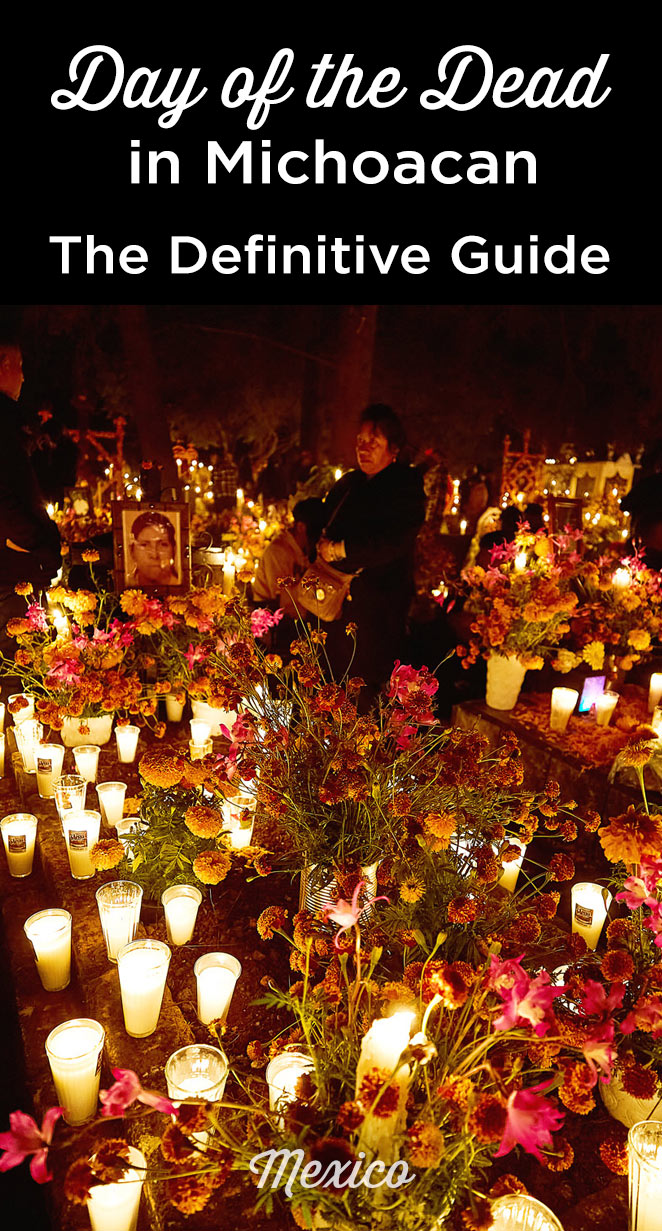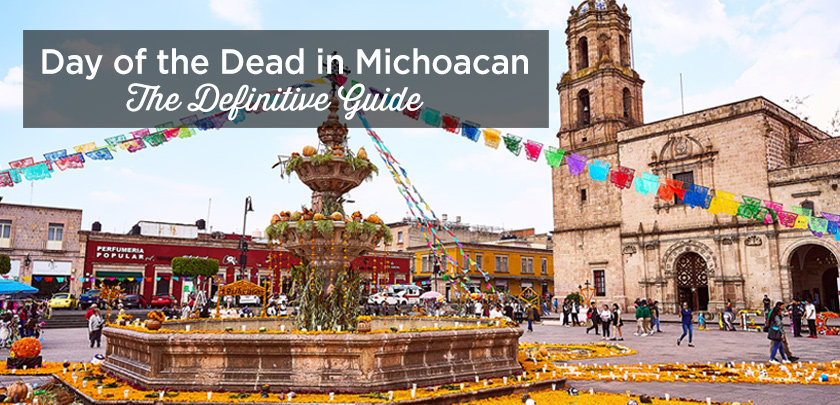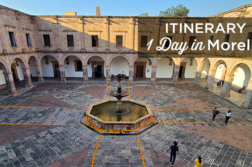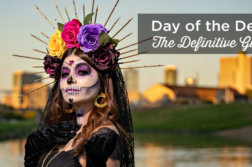Visiting Michoacan for Día de Muertos: Best Places, Tours & Tips
Dreaming of experiencing Day of the Dead in Mexico?
Great idea!
In the state of Michoacán—especially around Lake Pátzcuaro—this iconic celebration takes on a truly unique and spiritual dimension.
The local Purépecha communities honor their ancestors with candlelit cemetery vigils, vibrant altars, trails of cempasúchil flowers, music, and traditional food offerings shared with the souls of the departed.
In this complete guide to Día de Muertos in Michoacán, I’ll share everything you need to know: whether it’s really worth visiting Janitzio Island, which tours and excursions offer the most authentic experiences, and my 3 suggested itineraries for a first-time visit.
You’ll also find my top hotel recommendations and plenty of practical tips to help you plan your trip, respect local traditions, and truly immerse yourself in this unforgettable celebration.
Ready to discover how to visit Michoacán for Day of the Dead? Let’s dive in.
Sommaire
- Visiting Michoacan for Día de Muertos: Best Places, Tours & Tips
- 1. Why Visit Michoacán for Day of the Dead?
- 2. Best Places to Celebrate Day of the Dead in Michoacán
- 3. Things to Do During Day of the Dead in Michoacán (Activities & Events)
- 4. Janitzio on Day of the Dead: Authentic Experience or Tourist Trap?
- 5. Day of the Dead in Michoacán: Top Places to Stay
- 6. Should You Book a Tour for Day of the Dead in Michoacán?
- 7. Best Day of the Dead Itinerary in Michoacán for First-Time Visitors
- 8. How to Get to Michoacán for Day of the Dead
- 9. Is It Safe to Travel to Michoacán for Day of the Dead?
- 10. Essential Tips for Experiencing Day of the Dead in Michoacán
- 11. Traditional Foods to Try During Día de Muertos in Michoacán
- 12. Día de Muertos in Michoacán: Everything You Need to Know (FAQ)
- 12.1 Is it possible to visit several villages in one night?
- 12.2 Is Speaking Spanish Necessary to Enjoy Día de Muertos in Michoacán?
- 12.3 Can You Visit Día de Muertos in Michoacán with Kids?
- 12.4 Day of the Dead in Oaxaca vs Michoacán: what’s the difference?
- 12.5 No Hotel for Día de Muertos in Michoacán? Here’s What You Can Do
- 12.6 Can I take photos during Día de Muertos?
- Find a Cheap Flight to Michoacán
- You’re traveling in Mexico? These articles will help you!
1. Why Visit Michoacán for Day of the Dead?
Día de Muertos is celebrated in many parts of Mexico, but Michoacán occupies a special place.
In this region, the festival is closely linked to the ancestral traditions of the purépecha people, and this influence is felt in the rituals, songs, offerings and vigils.
Around Lake Pátzcuaro, families spend the night in the cemeteries with their deceased, in an atmosphere that is both intimate and deeply symbolic. Each village has its own rites, its own rhythms – a diversity that makes the experience unique and profoundly moving.
Finally, Michoacán is also one of the few places where this celebration takes place in an exceptional natural setting: between villages, hills and the shores of the lake, the environment enhances the atmosphere, particularly during the boat crossings to the islands on the night of November 1st to 2nd.
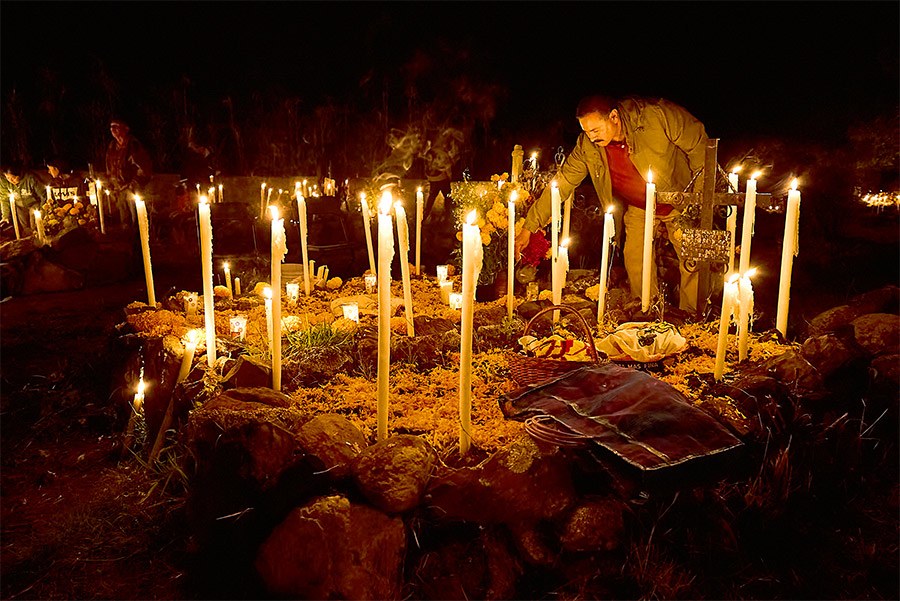
2. Best Places to Celebrate Day of the Dead in Michoacán
The region of Pátzcuaro concentrates most of the celebrations, but you should know that there’s plenty to discover throughout the state of Michoacán! It is estimated that over 300 activities are planned in the various communities during Día de Muertos.
Here’s an overview of the most emblematic places for a first visit to Michoacan for the Day of the Dead:
2.1. Pátzcuaro
Pátzcuaro is the ideal starting point for exploring the region during Día de Muertos.
This small town is my favorite in Michoacan, with its cobbled streets and colonial charm, but it’s even more beautiful during the Day of the Dead!
The downtown area comes alive in the last days of October, with public altars, craft markets, catrina competitions, traditional shows and streets decorated with cempasúchil petals. The atmosphere is festive, but always rooted in respect for tradition.
The Plaza Vasco de Quiroga becomes the heart of the celebration. This is where the Tianguis Artesanal is held, a large craft market where artisans from all over the state showcase their work. You’ll find ceramics, textiles, wooden objects, masks, catrinas and much more.
Although the town attracts a lot of people at this time of year, it remains a convenient, central base for visiting the surrounding area. Accommodation fills up very quickly, so it’s best to book several months in advance!
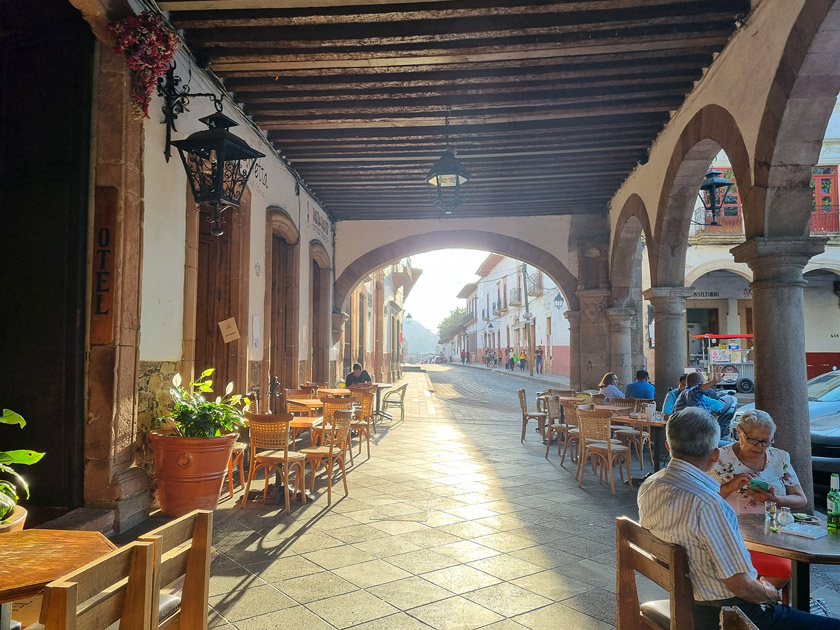
2.2. Janitzio
The island of Janitzio is the most emblematic place to experience Día de Muertos in Michoacán!
Every year, on the night of November 1st to 2nd, hundreds of boats leave the shores of Lake Pátzcuaro for the island, which is lit by candles and animated late into the night. The atmosphere is unique, but expect large crowds.
A must-see site in Janitzio is, of course, its small cemetery: make this your first stop, as the queue grows quickly and can block the entire access street.
Afterwards, take your time to wander the narrow streets decorated for the occasion – frescoes, petals, craft stalls – and climb up to the imposing statue of José María Morelos (158 feet tall), placed at the top of the island.
From the explanade, the view of the lake and the illuminated boats is magnificent, and you can often witness the danza de los viejitos, a traditional purépecha dance.
You’ll see two queues: one to buy your ticket, the other to board. The boat ride takes about 20 minutes and costs around 80 pesos each way.
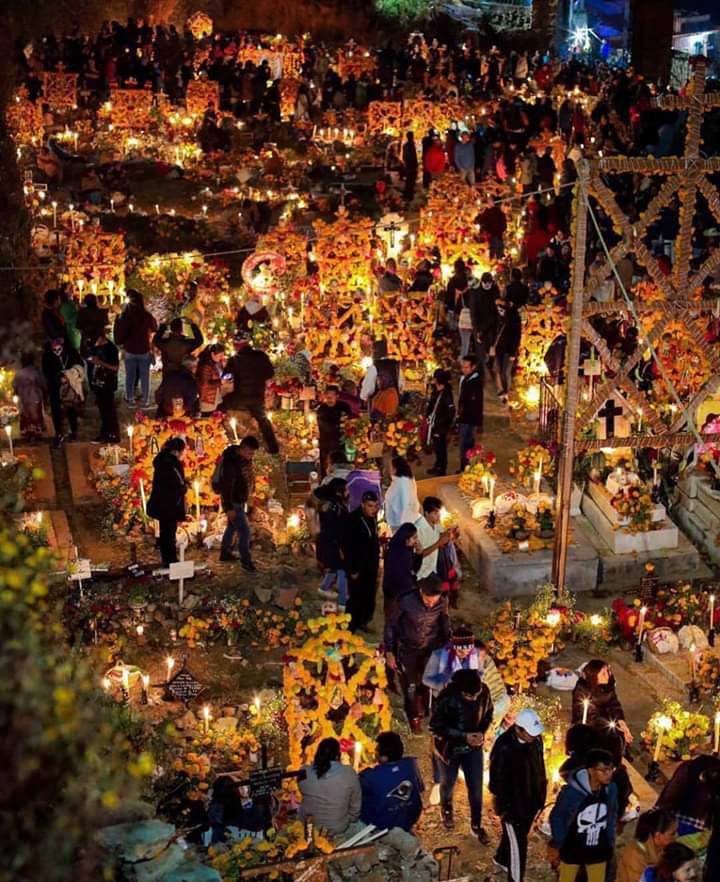
2.3. Tzintzuntzan
I really like Tzintzuntzan.
The atmosphere is strong and more relaxed than Janitzio, even if the place now attracts many visitors. The cemetery gradually fills up with candles, flowers, bows and live music, creating a very special atmosphere.
The inhabitants of Tzintzuntzan make a point of creating beautiful handcrafted objects to place on the altars: black or glazed pottery, white ceramics, straw angels, carved wooden fruits.
I also recommend the Santa Ana convent, founded in 1526, which was the first Franciscan convent in the region and Michoacán’s first cathedral!
Finally, don’t miss the crafts market. This is where I first discovered Michoacán’s local crafts (which definitely deserve more attention!): ceramics, textiles, painted wood, and traditional objects linked to Día de Muertos.
Right next door, you can visit the archaeological site of Tzintzuntzan, an ancient Purépecha ceremonial center with its famous circular structures called yácatas.
Be aware that at the end of the day, traffic becomes difficult and the return journey can be tricky. It’s not uncommon to have to walk a long way to find a crossing point, and cell phone coverage is limited.
If you use public transport, check the timetable at the Pátzcuaro bus station before setting off.
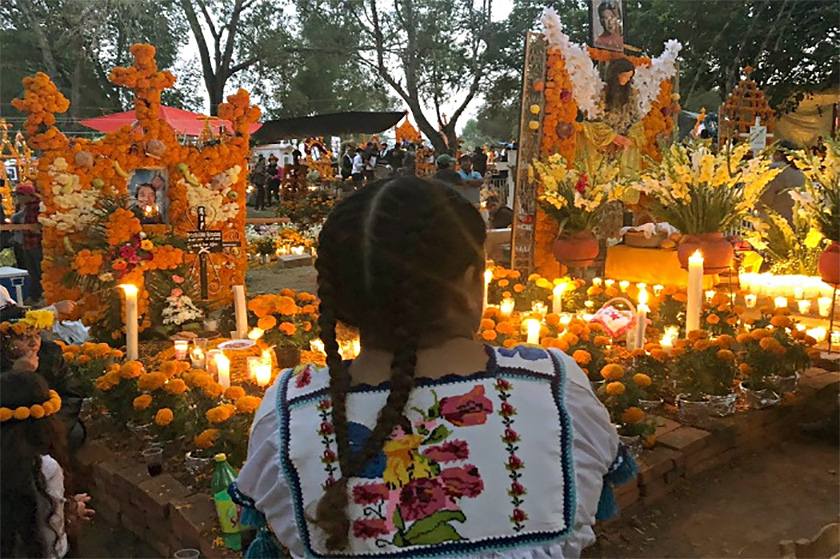
2.4. Morelia
Morelia is the capital of Michoacán and an excellent starting point for discovering Día de Muertos traditions.
It’s a large city with colonial charm, listed as a UNESCO World Heritage Site, which perfectly combines culture, architecture and gastronomy.
During the Festival of the Dead, the historic center is decked out in colorful decorations: public altars, flower petals, illuminations and giant catrinas.
I spent my last Dia de Muertos there and was amazed by all the decorations!
Among the must-see places during this period: the Plaza de Armas and its majestic cathedral, the Plaza Valladolid filled with different altars (a must!) as well as the Calzada Fray Antonio and the Santuario de Guadalupe.
Many other places are also beautifully decorated, such as the Palacio Clavijero, the house of José María Morelos y Pavón, etc.
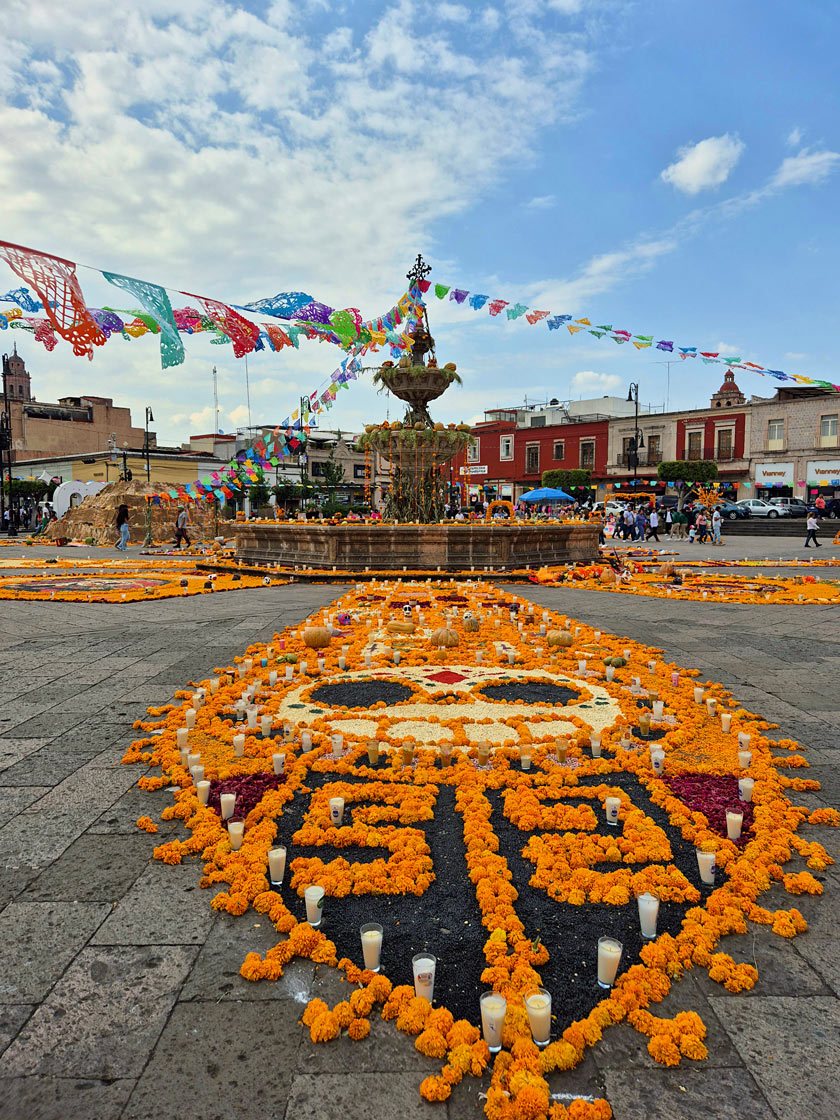
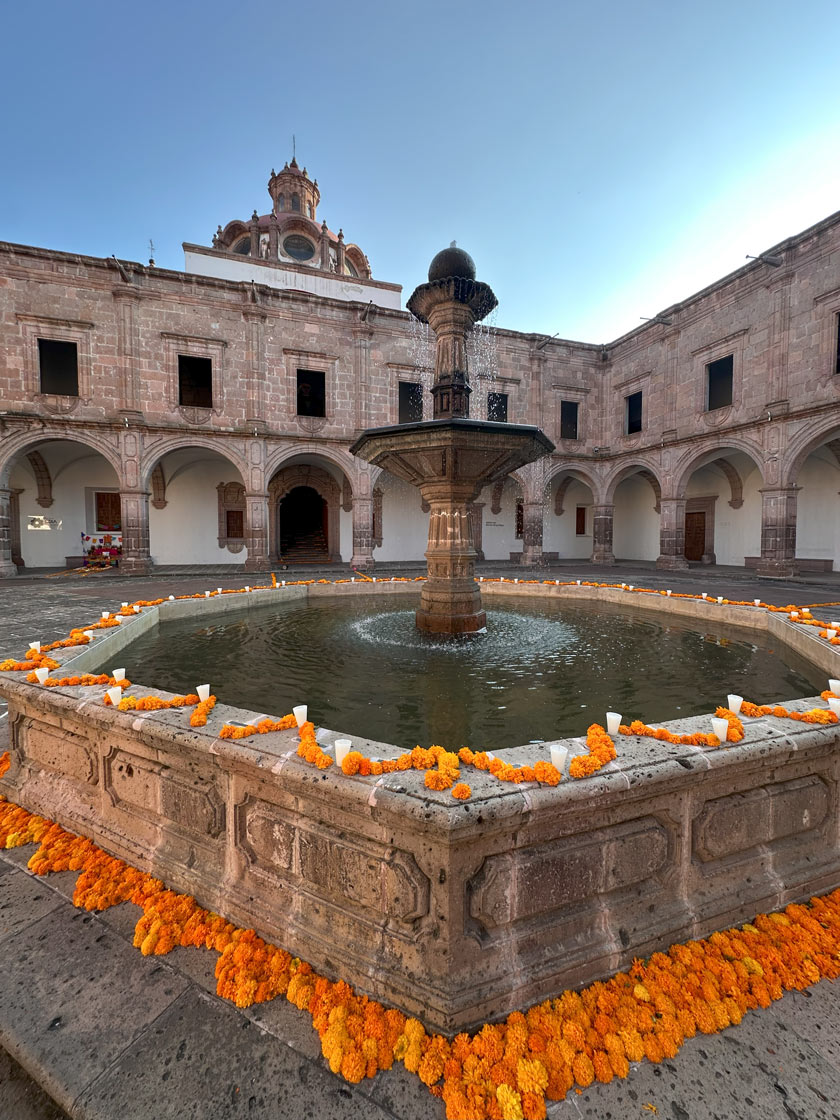
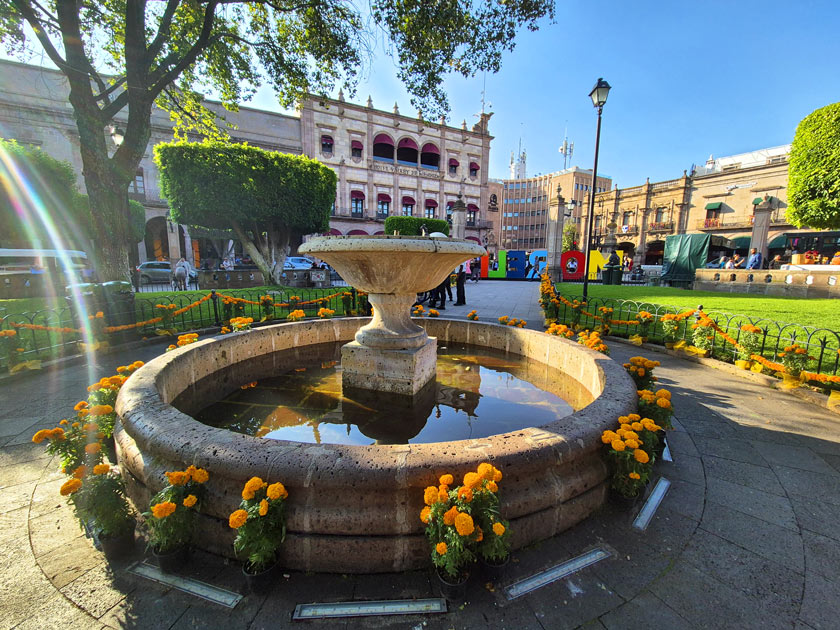
2.5. Tzurumutaro, Cucuchucho and Isla de la Pacanda
Here’s the Día de Muertos itinerary I followed in Michoacán: Tzurumutaro – Cucuchucho – Isla de la Pacanda. This is an excellent alternative route, quieter and more respectful than Janitzio, yet offering a real immersion in Purépecha traditions.
Tzurumutaro is one of Michoacán’s most beautiful cemeteries. At the entrance, an orchestra plays while families lay thousands of candles and flowers. In fact, there are so many flowers that the smell of cempasúchil fills the air! I was there around 8 p.m. and the atmosphere was already very lively.
In Cucuchucho, my personal favorite, the cemetery is smaller and more intimate: covered in flowers, with musicians who move wherever families call them; loved ones chat, children play, babies sleep.
Finally, Pacanda Island offers a more sober retreat. It is reached by boat from the Ucazanaztacua pier, on the same lake as Janitzio, but in an area with very few tourists. Locals begin decorating the graves around midnight, and a mass is held at the entrance to the cemetery.
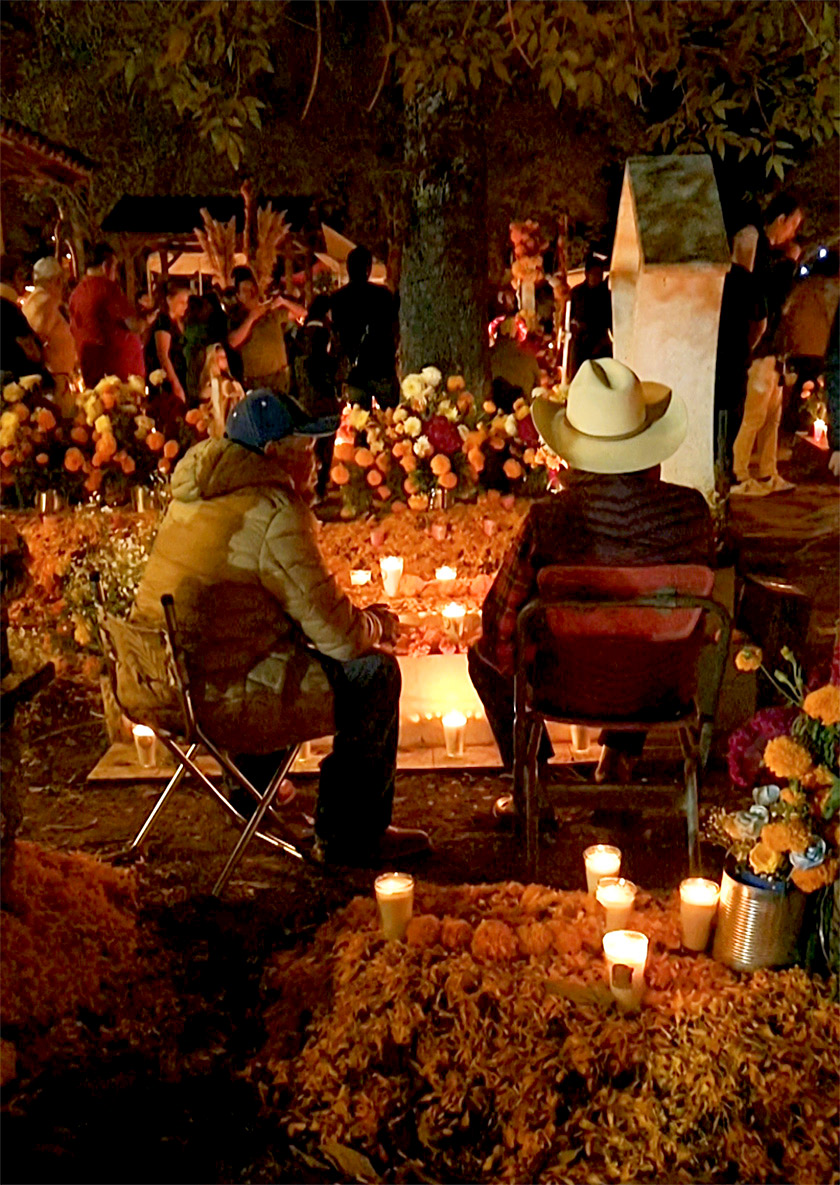
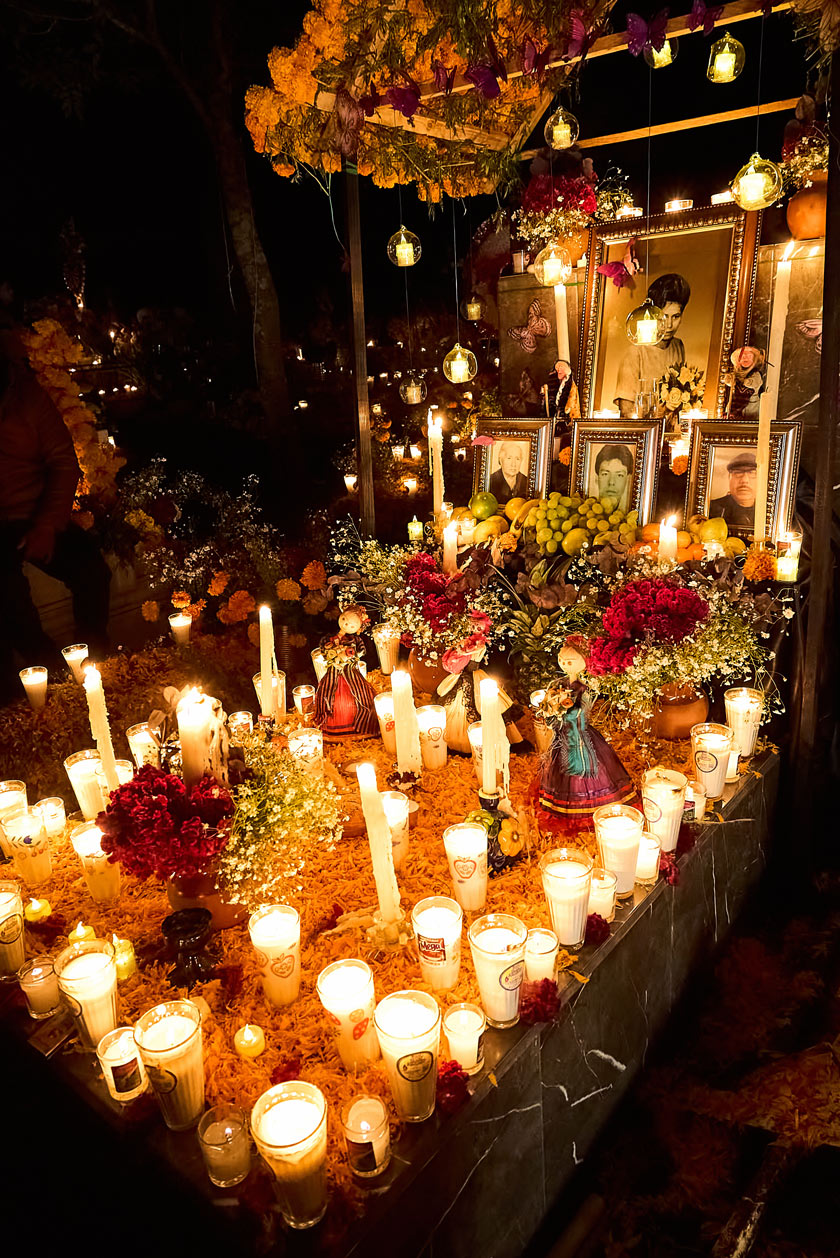
3. Things to Do During Day of the Dead in Michoacán (Activities & Events)
Día de Muertos in Michoacán isn’t just about the night of November 1st. For more than a week, several villages organize cultural activities, exhibitions, parades, vigils and craft markets. Here are the most interesting experiences to be had, depending on the location.
In Pátzcuaro, the festivities begin in mid-October with a large exhibition of calaveritas de azúcar in the Plaza Vasco de Quiroga. There’s also an artisanal tianguis, perfect for picking up festive items. From October 30th, the festival features a monumental altar, a floating arch on the lake, purépecha dance performances and an evening parade of mariposeros.
Morelia, the state capital, is filled with impressive decorations. Giant catrinas, flower carpets, colorful skulls and collective altars can be seen all over the historic center. The tourist tramway is also decorated for the occasion. An excellent option if you prefer a festive atmosphere in town.
In Tzintzuntzan, celebrations start on October 28 with floral arches, concerts, craft demonstrations and exhibitions. On the evening of November 1st, the procession through the Atrio de los Olivos and the vigil in the two cemeteries create a magical moment, enhanced by a video mapping show.
Tzurumutaro attracts many visitors each year thanks to its richly decorated cemetery. On November 1st, a mass, procession and candle-lighting create an intimate and moving atmosphere. Traditional cookery stalls also offer the chance to sample typical festive dishes.
On the island of Pacanda, the festivities are more discreet but just as symbolic. Inhabitants decorate their homes and cemeteries with arches, offerings and candles. Deceased children are celebrated from October 31st, then adults the following day, with prayers, music and a show of luminous butterflies on the dock.
From October 20th, Santa Clara del Cobre organizes a series of festive activities in the main square: altar display, face-painting competition, parade of catrinas on bicycles, floats and craft markets. An interesting place to visit if you’re in the area before November 1st.
From October 25th, several villages around Lake Pátzcuaro offer participatory activities based on Día de Muertos traditions. Ideal for a more in-depth discovery of the region:
- Copándaro: guided stroll through the fields of cempasúchil flowers, emblematic of the festival.
- Cuanajo: workshop for making caballitos de madera, small wooden horses given to the deceased.
- Pátzcuaro: workshop to create traditional altars and learn how to compose a complete offering.
- Manantiales de Urandén: night-time themed tour of souls and the world of the dead.
- San Jerónimo Purenchécuaro: workshop and tasting of dishes prepared for souls – an excellent way to discover the culinary symbolism of the festival.
- Santa Fe de la Laguna: candle-making workshops, pottery and traditional sugar sweets.
- Tzintzuntzan: clay pottery workshop, an ancestral local skill linked to funeral rites.
- Ihuatzio: chuspata (lake rush) basketry workshop, used to make offering objects.
- Tócuaro: traditional mask workshop, typical of processions and cultural performances.
- Capula: Feria de la Catrina: a major event featuring crafts, gastronomy and festivities around the famous Día de Muertos figure.
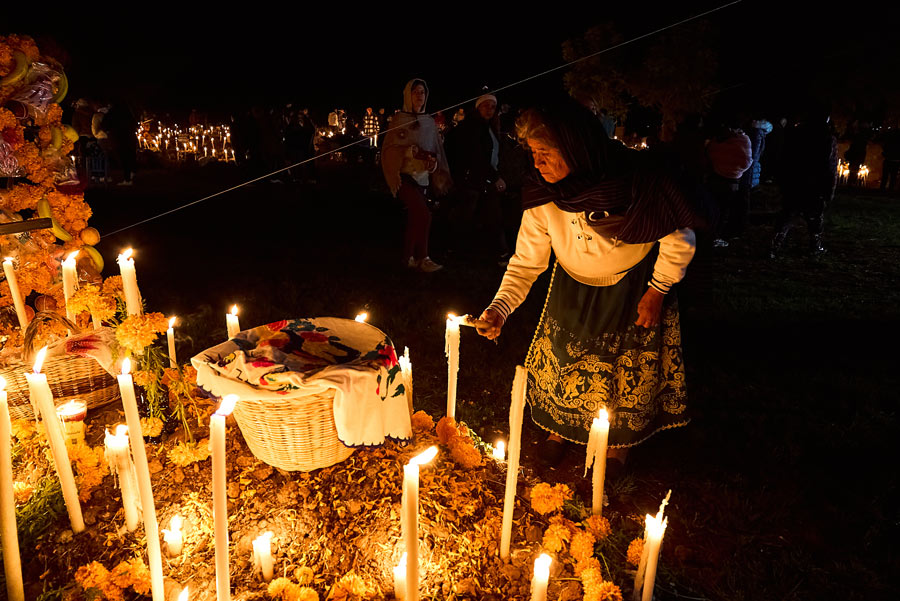
4. Janitzio on Day of the Dead: Authentic Experience or Tourist Trap?
The island of Janitzio is undoubtedly the best-known place in Mexico to spend the night of Día de Muertos.
The image of its illuminated cemetery and candlelit boats crossing the lake has become emblematic. If this is your first visit to Michoacán, it’s an impressive experience!
But this fame comes at a price: it’s very crowded.
On November 1, the queue to embark can be very long, the boats are full, and the island itself becomes difficult to navigate, especially as the evening progresses.
So arrive early, be patient, and accept a less intimate atmosphere than in other villages.
But if the crowds don’t bother you too much, Janitzio is clearly worth the detour.
On the other hand, if you prefer a quieter atmosphere, closer to the local communities, you might consider alternatives such as Tzintzuntzan, Cucuchucho or Isla de la Pacanda, which are just as authentic and often quieter.
5. Day of the Dead in Michoacán: Top Places to Stay
5.1 Pátzcuaro: at the heart of the celebrations
Pátzcuaro is the ideal starting point for exploring the lakeside villages and attending Día de Muertos vigils.
The atmosphere in the city center is magical from late October onwards. Accommodation sells out very early on, so it’s best to book several months in advance to find something well located and good value for money.
5.2 Tzintzuntzan and surrounding villages
Some villages like Tzintzuntzan or Santa Fe de la Laguna also have a few accommodation options.
These are ideal if you’re looking for a closer-to-the-community experience, but accommodation options are limited, so get in early there too.
5.3 Morelia: a good alternative
The state capital, Morelia is a beautiful colonial city just 1.5 hours’ drive from Pátzcuaro. It’s a great alternative if you run out of options in Pátzcuaro.
But book at least a month in advance: many visitors make the round trip for the vigils.
Last time, I stayed in Morelia and it was lovely – I don’t regret it!
Here are my recommendations for Accommodation in Morelia for all budgets:
- OYO Hostal Mich: This budget hostel is located in Morelia’s historic center, near the Plaza de Armas. It offers lockers, fans, and free Wi-Fi. Prices start at 10 $USD 0 per night in a shared dorm or 16$ per night in a private room.
- Casa José María: This charming hotel is a colonial-style mansion with a garden and terrace. It’s located in Morelia’s historic center, near the Museum of Natural History and the Aqueduct. The rooms are bright and cozy, with wooden furniture and floral details. They offer private bathrooms, air conditioning, and free Wi-Fi. Prices start at 40 usd per night, breakfast included.
- Casa Vieja Hotel Boutique: This boutique hotel is a restored 18th-century mansion with a terrace and garden. It’s located in the historic center of Morelia, near the Conservatory of Music and the Museum of Contemporary Art. The rooms are modern and elegant, with wooden furniture and original artwork. They feature private bathrooms, a coffee maker, and a flat-screen TV. Prices start at 143$ usd per night, breakfast included. Highlights: Artistic ambiance, comfortable beds, spacious rooms, and central location.
- Hotel de la Soledad: This 5-star hotel is a beautiful colonial mansion with a courtyard and fountain. It’s located in the heart of Morelia, just steps from the cathedral and main square. The rooms are charming and inviting, with wooden floors and colorful tiles. They come with private bathrooms, a safe, and flat-screen TVs. Prices start at 207$ usd per night, breakfast included. Highlights: Traditional decor, attentive staff, delicious breakfast, and peaceful atmosphere.
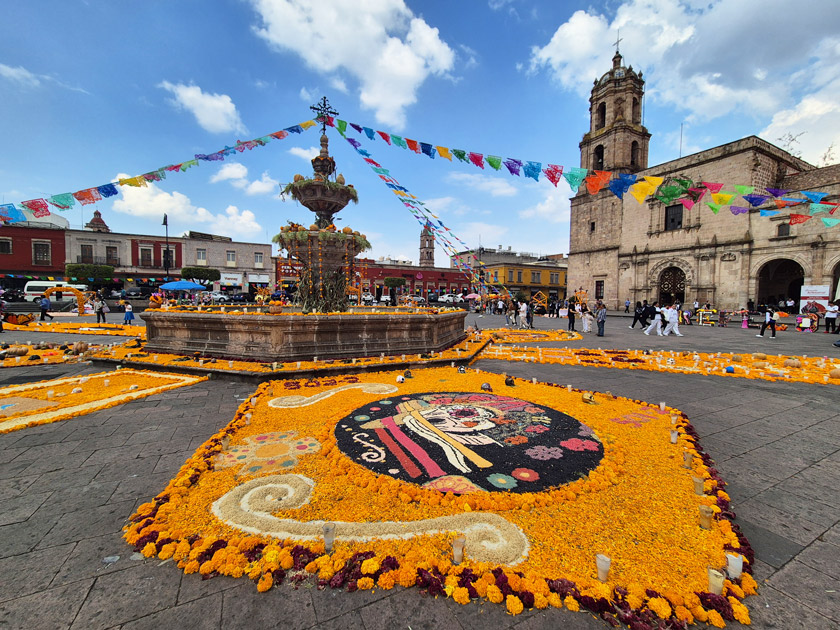
6. Should You Book a Tour for Day of the Dead in Michoacán?
One year, I chose to book a tour because I didn’t know the Michoacán region at all.
Even though I speak perfect Spanish, I preferred to have someone local tell me where to go and take care of the transport. And honestly, I didn’t regret it!
During Día de Muertos in Michoacán, things get chaotic very quickly: lots of people, blocked roads, parking difficulties, and it’s not always easy to know which village to go to when.
With an organized Día de Muertos tour, you don’t have to worry about logistics: you’re taken from one place to another, you have time to enjoy the villages without running, and you live the experience stress-free.
If you prefer to attend Dia de Muertos in Michoacan with a local guide, here are my 3 recommendations:
1. Día de Muertos in the villages around Lake Pátzcuaro (November 1st)
You’ll start the tour in Pátzcuaro (or from Morelia) and visit several local communities such as Tzurumútaro, Santa Fe and Tzintzuntzan.
The tour includes travel, visits to cemeteries, family altars, cultural explanations and free time to observe traditional rituals.
2. Complete Día de Muertos tour from Morelia: Capula, Santa Fe, Pacanda and more (November 1st)
You’ll start the tour in Morelia to visit several emblematic villages like Capula, Quiroga, Santa Fe de la Laguna, Tzurumútaro, Pacanda Island and Tzintzuntzan.
Accompanied by a local guide-driver, you’ll discover the different traditions of each community: the Feria de la Catrina in Capula, the great arches of Pacanda and the traditional vigils in Tzintzuntzan.
The tour includes transportation, visits to cemeteries, family altars, cultural explanations and free time to observe the rituals.
3. Dia de Muertos to Janitzio and Tzintzuntzan from Morelia (November 2)
You’ll depart from Morelia for a full-day excursion to the island of Janitzio, with a boat ride included, to experience one of Mexico’s most iconic Día de Muertos celebrations.
The tour also includes a stop in the village of Tzintzuntzan, known for its Purépecha traditions and cemetery.
You’ll learn more about the indigenous roots of this ancestral festival from your guide, while enjoying an itinerary optimized to avoid crowds. A lunch stop is planned to sample the region’s traditional cuisine.
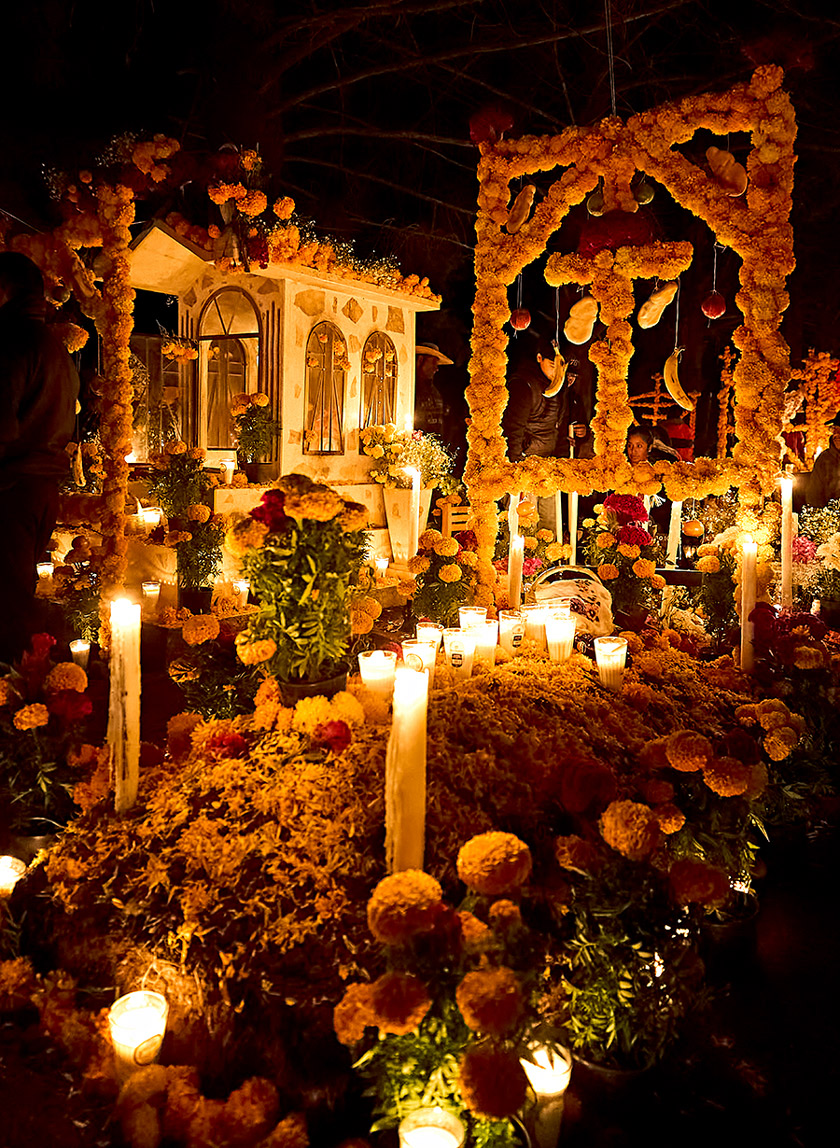
7. Best Day of the Dead Itinerary in Michoacán for First-Time Visitors
Día de Muertos is celebrated in many villages around Lake Pátzcuaro, each with its own rituals and atmosphere.
Here are three suggested itineraries for experiencing Día de Muertos in Michoacán on a first visit.
7.1 Option 1 – The must-see Janitzio
October 31st – Enjoy Patzcuaro
There’s plenty of entertainment and decorations in the center of Patzcuaro, so you can spend the whole day strolling around.
November 1st – Vigil on the island of Janitzio
Leave in the afternoon for the island, by boat from the main dock in Pátzcuaro. It’s a very special place: illuminated cemetery, offerings, music and meditation. Beware, it’s crowded – plan to arrive early!
November 2nd – Tzintzuntzan
After an intense night, it’s time to explore another emblematic village, Tzintzuntzan, where the arches and the atmosphere at the cemetery are just as impressive, but a little less touristy.
7. 2 Option 2 – Local and authentic alternative
October 31st – Explore Patzcuaro
The city center is beautifully decorated for the Festival of the Dead! Don’t miss the heart of the festivities: the Plaza Vasco de Quiroga, home to the “Tianguis Artesanal”, the large arts and crafts market.
November 1st – Lake Patzcuaro Villages
Start the evening at the Tzurumutaro cemetery, considered one of the most beautiful in Michoacan
Continue on to the Cucuchucho cemetery, more intimate and family-oriented, but just as colorful!
Then make your way to the Ucazanaztacua jetty on Lake Patzcuaro, to cross over to Isla de la Pacanda. Once on the island, climb to the top of the path, where you’ll find the cemetery.
November 2nd – Traditional atmosphere
Discover Santa Fe de la Laguna or San Jerónimo Purenchécuaro, villages that are very attached to their traditions, where decorations are still visible and the atmosphere remains festive.
7. 3 Option 3 – Artisan Traditions and Evening Celebrations by Lake Pátzcuaro
Departure from Morelia
November 1st – Crafts and traditional evenings
From Morelia, spend the afternoon in Capula for its Feria de la Catrina and its superb clay creations.
Then on to Santa Fe de la Laguna, the village that inspired the film Coco, and San Jerónimo Purenchécuaro for a joyful wake in a small cemetery.
End the night in Tzintzuntzan, which offers one of Michoacan’s finest Festa de los Muerte experiences, with its colorful atmosphere.
November 2nd – Day trip to Janitzio and Pátzcuaro
Board a boat for the island of Janitzio and enjoy its unique atmosphere and Purépecha traditions.
Finish with an afternoon in Pátzcuaro to stroll between markets, altars and entertainment in the historic streets before returning to Morelia.
8. How to Get to Michoacán for Day of the Dead
8.1 Getting to Morelia
Morelia is the capital of Michoacán and the main point of entry into the state. It is also the region’s only international airport: General Francisco J. Múgica (MLM). Múgica (MLM) airport.
- By plane: Morelia is served by direct flights from Mexico City, Tijuana, Cancún and several U.S. cities (Houston, Dallas, Chicago, etc.).
- By bus: Morelia is well connected to the rest of the country by long-distance bus. From Mexico City (Terminal Norte), the journey takes around 4h30 with Primera Plus or ETN.
- By car: Allow around 4h from Mexico City, 3h30 from Guadalajara, or 1h10 from Pátzcuaro.
8.2 How to get to Pátzcuaro
The main Día de Muertos celebrations are concentrated around Pátzcuaro and its lake. It’s the ideal place to stay during this period.
- By bus: There are direct buses from Mexico City (Terminal Norte) to Pátzcuaro, with no change in Morelia. The journey takes around 4h30 with Primera Plus.
- By car: From Morelia, the route is direct and takes around 1h10. From Mexico City, allow around 5h, and 5h30 from Guadalajara.
8.3 Should I rent a car to visit Michoacán during Día de Muertos?
Renting a car can be very practical if you want to explore several villages around Lake Pátzcuaro at your own pace, such as Tzintzuntzan, Tzurumutaro, Cucuchucho or Santa Clara del Cobre or the Ucazanaztacua pier.
This also means that you can attend the night vigils without having to depend on transport schedules.
But it’s not essential. During the Festival of the Dead, there are often special shuttles or tours organized from Pátzcuaro, Morelia or even Mexico City. Traffic can be tricky, and parking limited on the evenings of November 1st.
As with any budget, it’s very important to compare the different options to find the best car at the lowest price.
That’s why I recommend Booking.com Cars:
- The site presents a clear comparison of the different agency prices: a quick and easy way to find the best rate!
- Cancellation is often offered free of charge: very practical if you change your mind
- Booking Cars offers full insurance coverage at a lower price than the rental companies: instant savings with no effort
Click on the green button to find your car at the best price:
9. Is It Safe to Travel to Michoacán for Day of the Dead?
Not at all, as long as you stay in the tourist areas of Michoacán!
Pátzcuaro, Janitzio, Tzintzuntzan and Morelia welcome thousands of visitors every year for the Day of the Dead, in a festive, safe and traditional atmosphere. The presence of families, Mexican travelers and foreign tourists makes these places very lively, with a strong local organization.
Michoacán is a vast state, and some of its more remote regions can indeed be sensitive.
But this is not the case with the classic tourist routes around Lake Pátzcuaro. I’ve visited Michoacan several times, including during the Festival of the Dead, and have never had a problem. All you have to do is stick to well-known, well-frequented destinations.
A few precautions to keep in mind: avoid driving at night and don’t venture out onto country roads you’re not familiar with.
If you follow these basic tips, there’s no reason to be afraid of traveling to Michoacán for Día de Muertos.
10. Essential Tips for Experiencing Day of the Dead in Michoacán
Respect local traditions
Día de Muertos is not a show, but a time for families to reflect, even if the atmosphere is often festive.
Speak softly, walk slowly and avoid intrusive behavior. Be good visitors so that we remain welcome in these deeply symbolic places. Don’t touch the altars, don’t sit on the graves, and always observe with respect.
Please don’t do this. Even if some altars include mezcal or beer, that’s part of the family offering, not a collective gesture.
Can I take photos?
Yes, but with caution. Never photograph an altar or a family without asking permission. Some places, like the cemeteries of Tzurumutaro or Cucuchucho, are very lively, but that doesn’t mean you shouldn’t respect people’s privacy.
Book early
As in Oaxaca, accommodation around Lake Pátzcuaro fills up very quickly!
By September, all that remained were expensive, out-of-the-way or unattractive options in terms of quality/price. As soon as you have your dates, book your hotels. Don’t wait until the last minute.
Click here to discover your hotel options for dia de Muertos in Michoacan:
Anticipate traffic jams
The roads to villages such as Janitzio, Tzintzuntzan and Santa Fe de la Laguna are very busy on November 1, late in the day.
Arrive early, ideally in the late afternoon, and plan to walk, as many streets are blocked to traffic.
Prepare to walk
Between the crowds, the closed streets, the queues for the boats and access to the cemeteries, you’ll often have to walk for quite a while. Make sure you have comfortable shoes and are in good physical condition, especially if you’re visiting several places in one night.
What to wear
Nights are cool in the Pátzcuaro region. Take along:
- Warm clothing (jacket, scarf, hat, depending on how chilly you are)
- Practical, discreet clothing
- A headlamp or small flashlight (many cemeteries are poorly lit)
- Comfortable walking shoes
Money Tip for Visiting Michoacán During Día de Muertos
In the villages, there are not always cash dispensers, and small vendors do not accept cards. Carry cash to buy a hot ponche (fruit-based drink), a snack, a souvenir or to access temporary toilets.
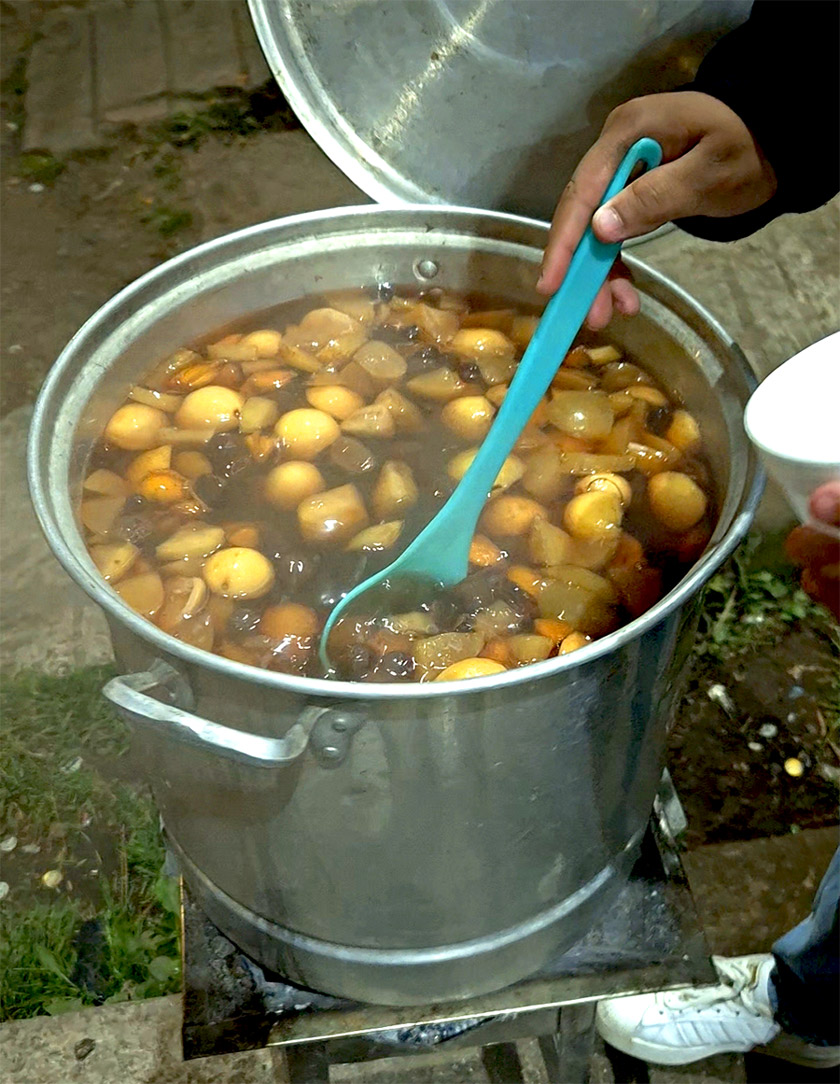
11. Traditional Foods to Try During Día de Muertos in Michoacán
Día de Muertos is also a culinary celebration. Throughout Michoacán, you’ll find traditional food stalls around the main squares and cemeteries, especially in villages like Pátzcuaro, Tzintzuntzan or Tzurumutaro.
Here are just a few of the must-try specialties to be sampled during evening gatherings:
- Atole: a hot corn-based drink, often flavored with vanilla, chocolate or strawberry.
- Tamales, especially uchepos (tamales sweetened with soft corn) and corundas, a Michoacán specialty served with cream and cheese.
- Pozole: thick corn and meat soup, perfect for warming up in the evening.
- Pan de muerto: sweet bread decorated with bone shapes, a common sight in local markets and bakeries.
- Dulces típicos: traditional sweets in the shape of skulls or animals, very colorful, found especially in Santa Fe de la Laguna.
If you’d like to learn more about the symbolism of the dishes offered to the deceased, San Jerónimo Purenchécuaro often organizes traditional cooking workshops linked to Día de Muertos.
You’ll learn how to prepare specific dishes for the souls of the departed, with tastings included. An authentic and enriching experience.
12. Día de Muertos in Michoacán: Everything You Need to Know (FAQ)
12.1 Is it possible to visit several villages in one night?
It is possible, but you need to plan your route carefully: choose villages close to each other and draw a realistic itinerary on a map (like the ones I suggest earlier in the article).
Take traffic jams into account: on November 1??, traffic is often heavier than expected, so calculate wide and allow time for parking.
If you’re planning to visit Janitzio, I suggest concentrating on the island, then visiting other places the next day.
12.2 Is Speaking Spanish Necessary to Enjoy Día de Muertos in Michoacán?
It’s always useful, but not mandatory.
However, a “Buenas noches”, a smile and a “¡Provecho!” to the families who are eating is always appreciated. Even basic Spanish makes it easier to talk and shows respect.
What’s more, it’s important to remember that we share a small space in cemeteries, so I don’t think it’s a good idea to bump into people and ignore them!
12.3 Can You Visit Día de Muertos in Michoacán with Kids?
Absolutely! If it’s magical for an adult, imagine it for a child.
Remember, though, that it’s going to be a long night: take water, snacks and warm clothes with you, and decide whether or not to eat on site (there are plenty of stalls), depending on your child’s temperament.
Keep a close eye on them: they can be distracted, and it would be a shame if they stepped on a grave or knocked over an offering.
12.4 Day of the Dead in Oaxaca vs Michoacán: what’s the difference?
The cultures are not the same: in Michoacán, we’re in Purépecha territory; in Oaxaca, there is mainly Mixtecs and Zapotecs.
The symbolism of flowers, candles and altars remains similar, but the crafts, music and gastronomy differ.
In Oaxaca, it’s all about the festivities, with grand parades, colorful make-up and street festivals; in Michoacán, it’s all about the pueblos purépechas, with cemetery vigils and ancestral rituals, notably on the island of Janitzio.
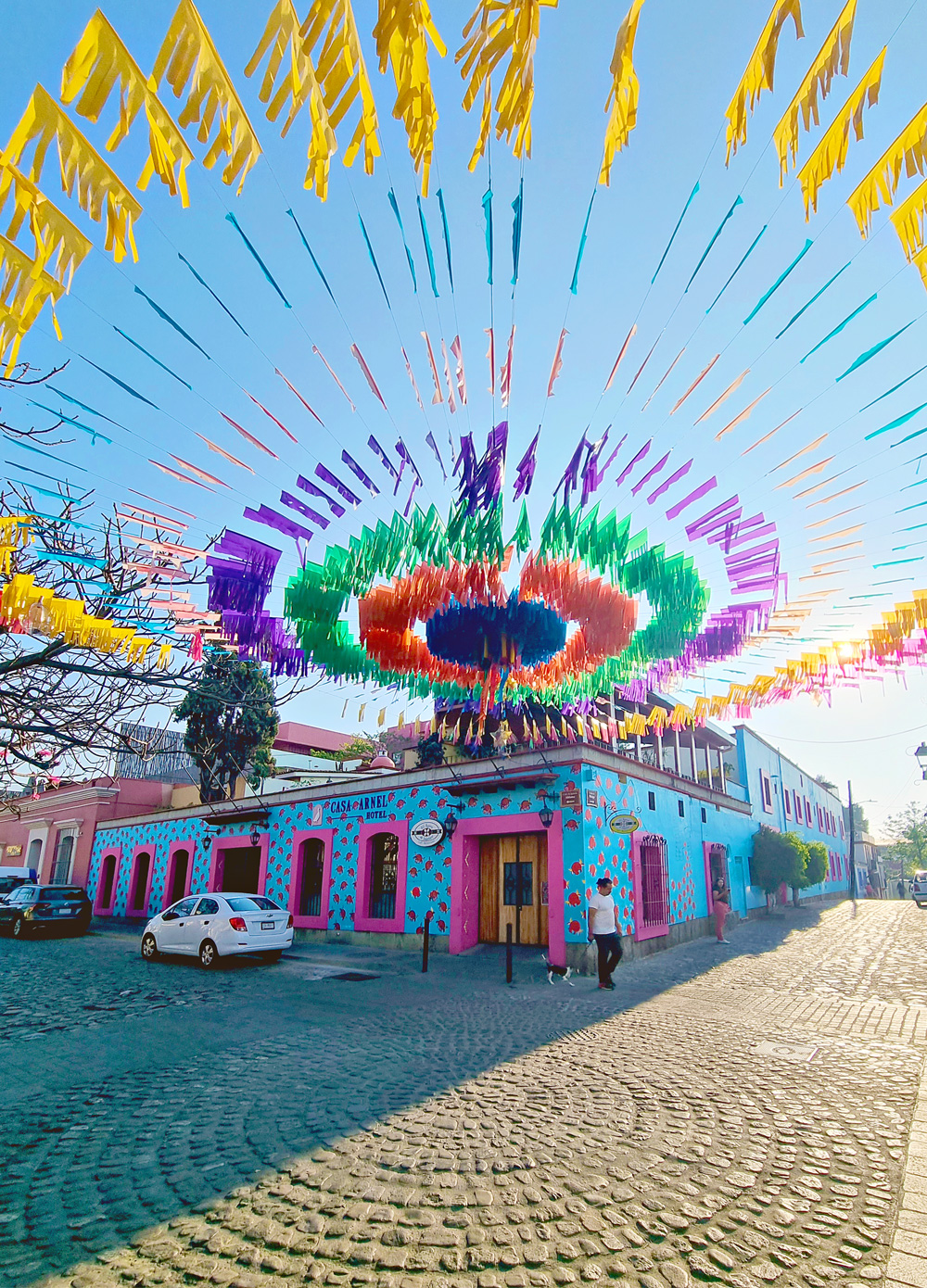
12.5 No Hotel for Día de Muertos in Michoacán? Here’s What You Can Do
At the last minute, try Morelia (it’s bigger, so there are more options) or Uruapan, but prices can go up pretty fast!
Last year, I almost missed the Festival of the Dead in Michoacán because I couldn’t find a room in my budget – I’ve learned my lesson: always book several weeks, or even months, in advance.
Another option: the villages around the lake, but more basic comfort and very limited availability.
12.6 Can I take photos during Día de Muertos?
Yes, in most cases locals are used to visitors taking pictures — but the key is respect and courtesy.
Always approach gently, greet them with a “Buenas noches,” and ask: “¿Le puedo tomar una foto?” Keep in mind: this isn’t a show or a performance — it’s a deeply personal moment for families honoring their loved ones. If someone declines, accept it gracefully and without hesitation.
Find a Cheap Flight to Michoacán
The Morelia International Airport (MLM) is the main airport serving Michoacán. It offers direct flights from Mexico City and several other major cities in Mexico and the United States. The flight from Mexico City (MEX) to Morelia takes just under one hour.
To find the best flight deals to Morelia and for domestic routes across Mexico, be sure to use our flight comparison tool powered by Skyscanner. It’s the easiest way to score unbeatable prices and book your ideal flight!
🚗 Rent a car
🗽 Book entrance tickets and guided visits
🏄 Book your sports activities
🌍 Take a travel insurance
🙎 Book a tour
✈️ Book your flight
You’re traveling in Mexico? These articles will help you!
Discover all my articles about Mexico: All my articles to help you plan your trip to Mexico are listed there.
The 35 Best Things to Do in Mexico
- Day of the Dead (Mexico): How to Celebrate Día de Muertos Like a Local
- Day of the Dead in Mexico City: All the Best Things to Do and See
- One Day in Morelia: What to Do & See
- How to Get to Morelia (Bus, Car, or Flight)
- Itinerary: 8-10 days in Mexico – From Mexico City to Oaxaca
- Itinerary: 10 days in Mexico – Mexico City, Chiapas and Yucatan
- Itinerary: 2 weeks in Mexico – Best itinerary to discover the Yucatan Peninsula and Chiapas!
- Itinerary: 3 weeks in Mexico – Mexico City, Puebla, Oaxaca, Chiapas, Campeche, Yucatán and Riviera Maya
- Itinerary: 1 month in Mexico – My Epic 30-31 Days Itinerary from Mexico City to Cancun
- Road trip in Mexico: The best itineraries for 10, 15, 21 days and a month
- Itinerary: 1 week in Yucatan – The Ultimate 6, 7 or 8 days Itinerary
- Itinerary: 10 days in Yucatan – Best Itinerary for 9, 10 or 11 Days in Yucatan
- Itinerary: 2 weeks in Yucatan – Epic Itinerary + All my Best Tips!
- Itinerary: 3 weeks in Yucatan – Best things to do in 20-21 days
- Itinerary: 1 month in Yucatan – Yucatan Peninsula in 29, 30 or 31 days from Cancun
- Road trip in Yucatan: The best itineraries for 7, 10, 15, 21 days and 1 month
You’re using Pinterest? Here is the picture to pin!
